Finding signs of wild animals in sandy stream beds, wide riverbanks,
in dense forest understorey, often riddled with those of the domestic kind –
the livestock – is like going on a treasure hunt. Every afternoon when we
returned we sat under the warm winter sun listening to each other’s finds. I
found a pile of scat on a boulder, full of hair, fluffed up because it was old
and dry, and while I discussed my contemplation on the field to assign it to
its rightful owner, my companions yelled their opinion at once: jackal
hai re! Well, jackals do love relieving
themselves on boulders, unlike cats that prefer to do so away from a
pugdundee, or antelopes that have
specific latrine sites.
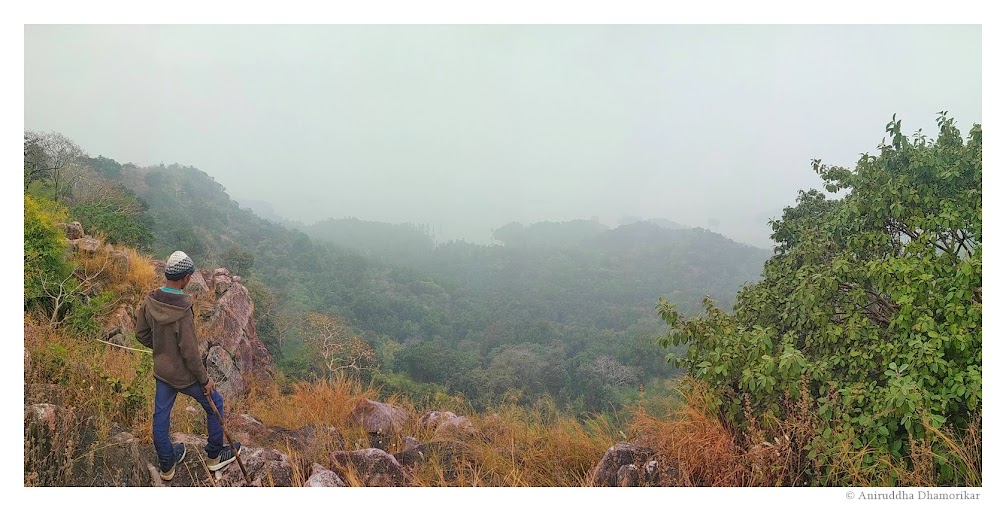 |
| On this particular survey, I stood on a 700 m escarpment overlooking the backwaters of Bansagar on Son. |
There was an undeclared competition among us; if I said I
found tiger’s pugmarks, one of my colleagues found water trailing another’s by
the river, and another found a tigress with adolescent cubs! You could never
win. This treasure hunt kept us engaged for the whole two months we were
conducting occupancy study in the forests connecting two important tiger
reserves of Madhya Pradesh, Bandhavgarh and Sanjay.
 |
The smallest to the biggest pug marks; clockwise from top-left: a small rodent,
a palm civet, a tiger and a sloth bear |
Treading the desire paths on sleepy winter mornings, our
breaths visible under our nose, we went ahead with no clue of what lay ahead.
With little in our stomachs except for the delicious chai our kind associate
brewed, we headed out scourging ten to fifteen kilometres of forests at a stretch
(the team effort adding up to over fifty to sixty kilometres per day), looking
for signs from that of a wild pig to that of the tiger. At times we found
nothing even as we breached through the barb-wired tangle of lantana, climbed
steep hills only to realise that the sole animal to feed here is the goat, and
pushed through village edges and farmlands.
Then there were days when I just couldn’t have enough of
tigers, their big, wide pugmarks surrounding me as if they played all around
the night before I ventured. Our learned companions in the craft who led us on
the trail, the forest guards and chowkidars,
are not only the protectors but also finest naturalists I have ever met. I owe
it to them for turning our surveys into exciting walks in the woods.
 |
| Fruits of a sign survey: sharing the ground with the tiger |
The fruits of sign survey are immensely satisfying, but I am
going to keep the philosophical fruits aside for the moment and focus instead
on the literal: the wild fruits. Winters of the tropics give you some delicious
fruits you can pick while exploring the forests. Every species with a nose and
eyes for fruits eats these, and we have been harvesting them for ages. Indeed,
if it wasn’t for the craft of our ancestors, we wouldn’t know what we can and cannot
eat; speaking for myself, I would dare not pick one without someone to assure
me that it is edible.
Our fieldwork lasted from December to January, the time of
peak winter when temperatures drop to their lowest for the year. This is a time
when many of the deciduous trees start to flower or fruit before shedding their
leaves in preparation for summer. I was fortunate to taste seven species that
were fruiting. I discuss these fruits based on their taste (from sweet to
bitter).
Among the most recognizable of all wild winter fruits of
central India is ber (Ziziphus sp.).
Now let me in you on a surprise; there are at least three species of ber in fruit in winters! It is fairly
easy to recognize ber wherever you go, thanks to their typical shrubby stature,
two sets of spines on each node: one straight and one hooked, and broad, oval
leaves with three longitudinal veins. But if you don’t want to be a botanist
yet, just the smell of a few ripe fruits can help to identify one.
 |
| A Jackal's unusual scat. Jackals are hunters, scavengers, but are also fond of ber. |
I happened upon the smallest of the species in the
unlikeliest of instances, a jackal’s scat! An uncommon diet for a small
carnivore, this small ber, locally
called mukaiya (Ziziphus oenoplia), is often consumed by jackals, sloth bears, as
well as small rodents and birds. It is a spindly climbing ber with twisted twigs and slender sharp spines, growing in dense
forests.
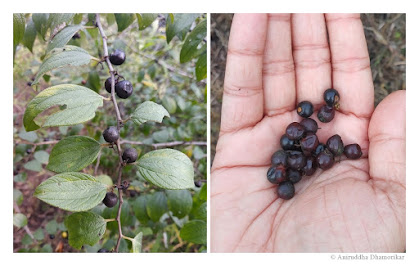 |
| Mukaiya/Makora - Ziziphus oenoplia, the smallest ber in the landscape |
In winters, they’re at their finest, their fruits with a dark coat as
they ripen hang in pairs from every node of the leaf. They’re a tiny morsel,
but a delicious one to pop into your mouth as you scan for signs. Come summer
and the plant will be bare, save for a few shrivelled leaves. This spiny tangle
is cut for its use as hedge around backyard gardens to deter animals from
venturing in, and it is said that because of this it has now become quite
uncommon to come by.
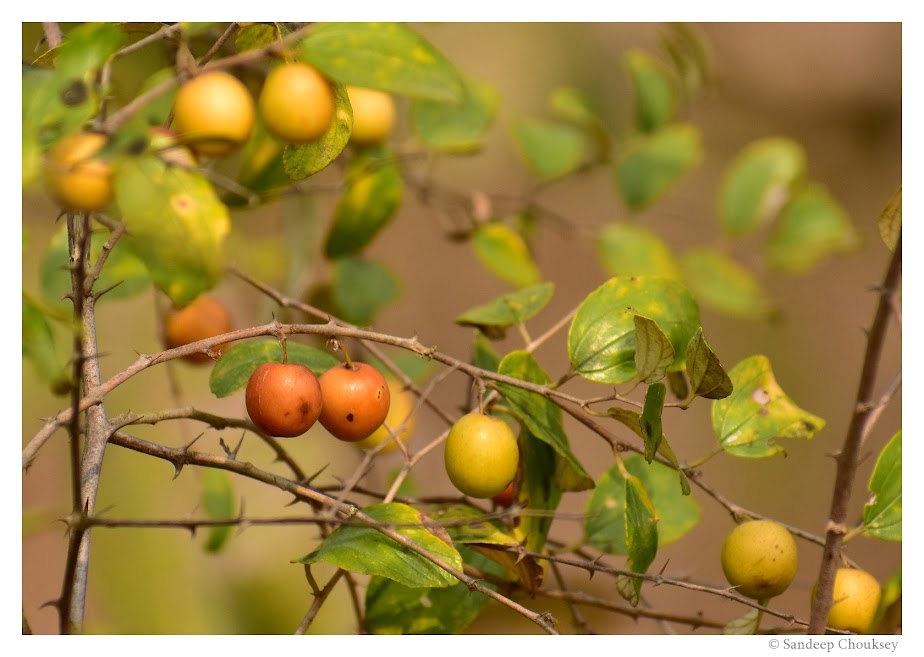 |
| Beri - Ziziphus nummularia, the second smallest ber in the landscape |
The drier, open forests are a favourite habitat of its
slightly bigger cousin, beri (Ziziphus nummularia). A small shrub
growing close to the ground with tiny leaves and very many spines, its fruits
turn amber as they ripen but are quite a task to pick from the tangle. This
shrub is a favourite among various animals as well, and in the arid west of
India is consumed by the critically endangered Great Indian Bustard.
 |
| Ber - Ziziphus mauritiana, the largest wild ber in the landscape |
The largest of the cousins we call ber (Ziziphus mauritiana)
is among the most hardy species found across India. With little disturbance it
can grow into a medium-sized tree. This is the largest wild ber fruit you will
come across – and trust me on this, no walk can be as delightful as happening
upon a grove with ripe fruits! If you’ve ever eaten one and thrown the seed
back into the forest, it is likely that it has taken root there. Other than us
saunterers, many animals eat the fruit and disperse the seeds. One of the
well-known visitor is the sloth bear – it visits ber trees even inside villages to feed on, increasing the chances
of close encounters with people.
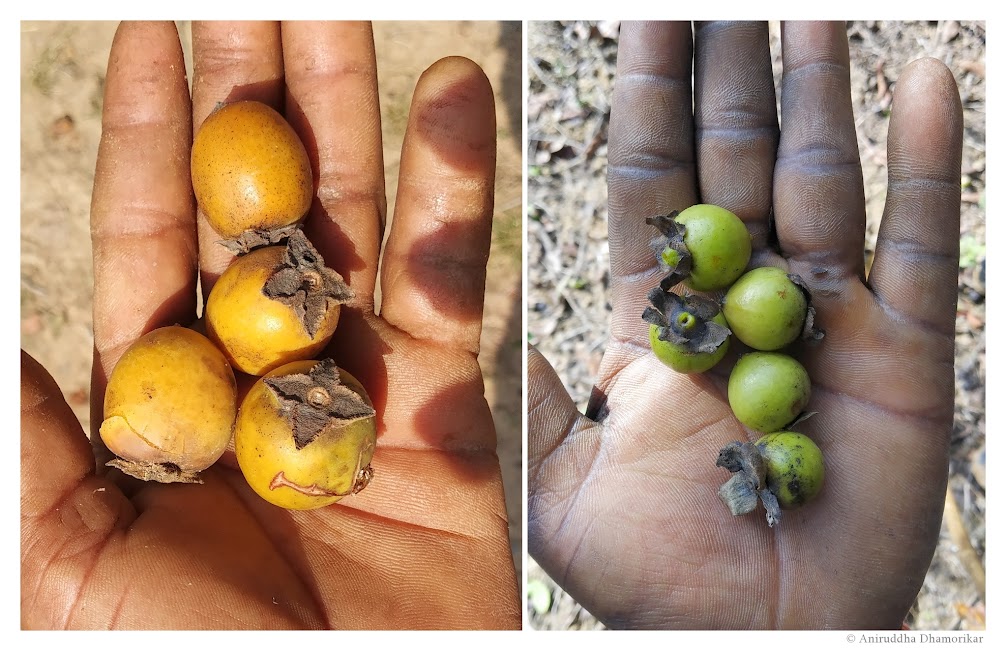 |
| Tendu (Diospyros melanoxylon) to the left and bistendu (D. montana) to the right share the same habitat in central India. |
If you ask me what is the most interesting of fruits to eat
in the wilds of central India, I will point you to tendu (Diospyros melanoxylon).
It is a tree known more for its leaves than fruits because its leaves are
harvested to make indigenous cigarettes – bidi.
These trees fruit early in winter and ripen by the end of it, but some fruits
mature quite early. They resemble small sapodilla (chikoo) with a hard outer cover, and even taste like one – but a
fair warning, eat only a few because the fruit can make your mouth go dry and
may also cause sore throat! The fruits are harvested for sale in weekly
markets, but the consumption and sale of tendu
fruits has significantly gone down over the years as tendu leaf trade picked pace a century ago. Although tendu is among the most common species
found in central India, seeing a larger tree is becoming more and more uncommon
because of constant cutting and lopping for the harvest of its leaves. Bistendu (Diospyros montana) is a cousin of tendu sharing the same space, virtually appearing like one except
for tapering leaves and smaller fruits which are not consumed.
 |
| Jungli karonda - Carissa spinarum is a small, tangy variety of karonda typically found in lateritic soils |
Mixed deciduous forests on lateritic soils – soils with a
distinct red tinge due to high iron oxide content – are the habitat of jungli karonda (Carissa spinarum), a shrub with glossy dark green leaves, stout
branches, and thorns. What may appear as displeasing throughout the summer
attracts attention during post-monsoons with its fragrant white flowers, and
begin to fruit in winters. For those with a liking towards tangy fruits, jungli karonda is a treat. The ripe
fruits are bluish-black in colour, and for some curious reason the taste varies
from tree-to-tree, some are extremely sweet, some tangy, and some are slightly
bitter. Jungli karonda fruits are
much smaller than the more common karonda
(Carissa carandas), and like the
latter, are also used to make delicious, tangy chutney!
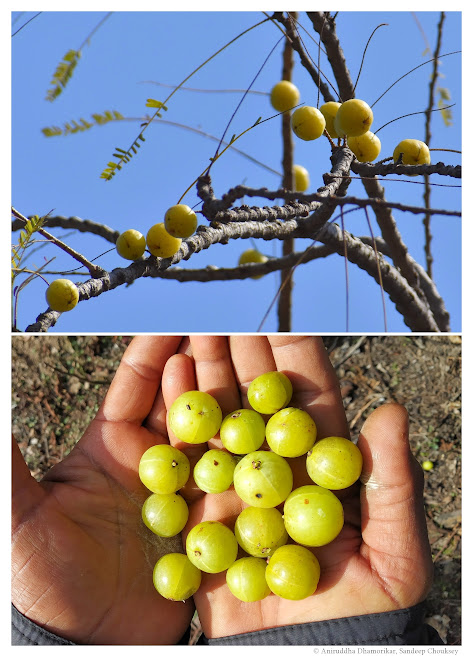 |
Aonla - Phyllanthus emblica, a tree of the dry deciduous forests of central India,
is an important non-timber forest produce for people living around forests. |
Perhaps the tangiest of fruits you may find in the central
Indian forest is also the most commonly known, aonla (Phyllanthus emblica).
Aonla trees when they fruit are a
sight to behold: their slender branches droop with the weight of the pale-green
fruits that grow across the length. Some species have really small fruits, some
a handful, but they’re all the kind of bitter that leaves a sweetish
aftertaste. Many ungulates, particularly sambar, consume these fruits. Aonla is used in various medicines as
well as for local consumption as chutney and pickle, for which the fruits are
harvested as soon as they mature – one reason why it is so rare to come across
a fully fruiting tree in the forests. This tree has now been grown
horticulturally, hence the pressure has come off the wild aonla, although it is still hacked for its timber.
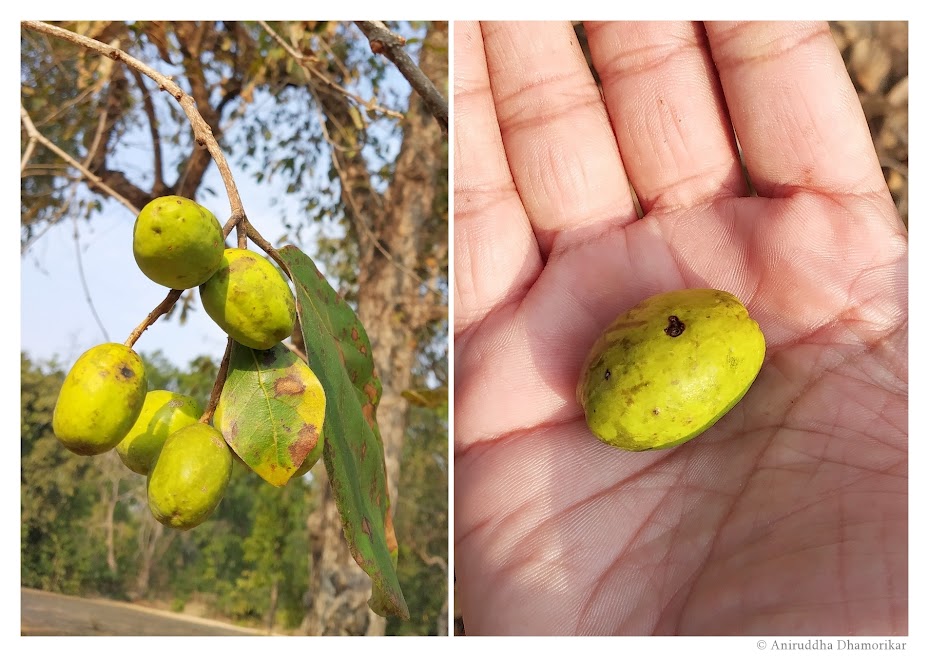 |
Harra - Terminalia chebula, is another bitter-tasting fruit that is harvested from the forests to be used sold.
The fruit is used in various ayurvedic medicines. |
The only fruit to up the game on the extreme taste is harra (Terminalia chebula) – a little bite will make you cringe. This
hard-as-a-nut fruit takes a year to mature; sometimes the tree retains its
previous batch of fruits while growing a new one! I would not recommend
snacking on it like one would on ber
and karonda, but it is worth trying.
Like aonla, it is also used in
ayurvedic medicine, and, along with bahera
(Terminalia bellirica), the trio
forms a famous medicine called triphala
churna (tri = three; phala = fruits; churna = powder) – used primarily to treat gastrointestinal
problems.
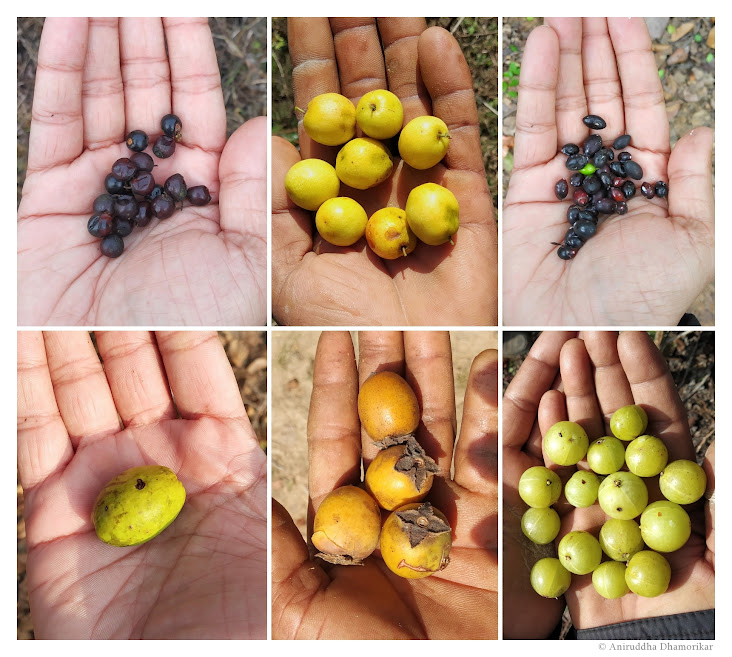 |
The winter fruits of central India that I could cherish (clockwise from top left):
mukaiya, ber, jungli karonda, aonla, tendu, and harra. |
It is quite unlikely for me to come back without having
tasted a tasty morsel offered by the trees. The trees we discussed are the flagship
species of the forests, helping us understand the importance of trees in
providing resources (leaves, flowers, and fruits) to animals, with animals
playing an equally important in pollination and seed dispersal. A 100-pager
monograph on beri (Z. nummularia) written in 1981 outlines the
role of this small inconspicuous shrub in the food web of an arid ecosystem.
Imagine a food web with more such shrubs and trees at the centre; and imagine
now if they disappear.
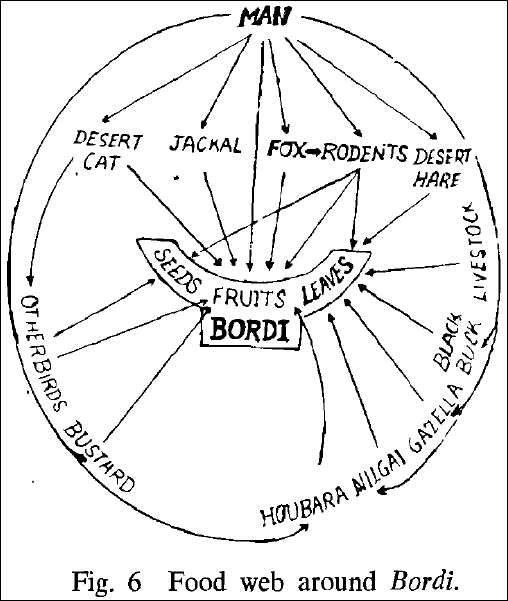 |
| Food web around Beri (Z. nummularia; Bordi in Gujarati), illustrated in a 1981 monograph on the species by Mann & Saxena (eds.) 1981. Bordi a shrub of the Indian arid zone - its role in silvipasture. Central Arid Zone Research Institute. |
These trees represent an excellent example of shared resources
between wild animals and humans. Our reliance on such trees has brought us a
long way. Our culture revolves around trees. However, times are changing. Many
of the rangers expressed concern over fruiting trees becoming less and less
common. Over-extraction has affected regeneration, and forest fires, in
addition to overgrazing, has slowed the growth of new forests. These trees and
shrubs I talk about represent a larger but dwindling tree diversity of the
central Indian forests, and it made me think, what if such trees were to
disappear? If the forests fail to feed, where will the chital, langur, bear, and the tiger go?
Comments
Post a Comment